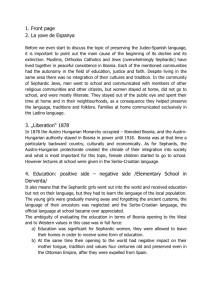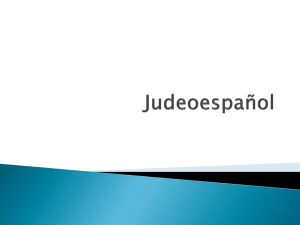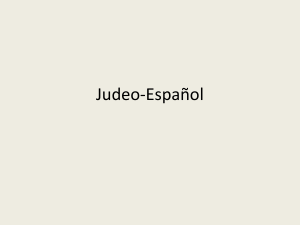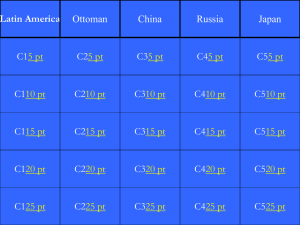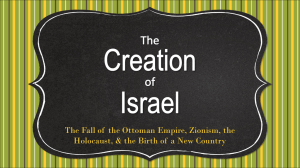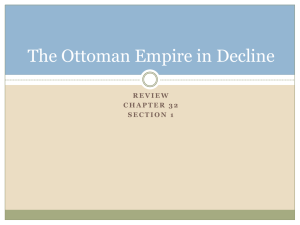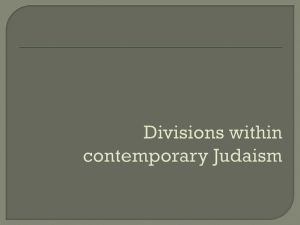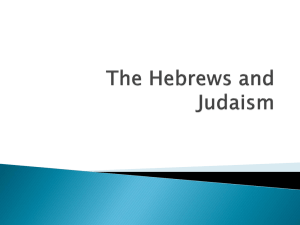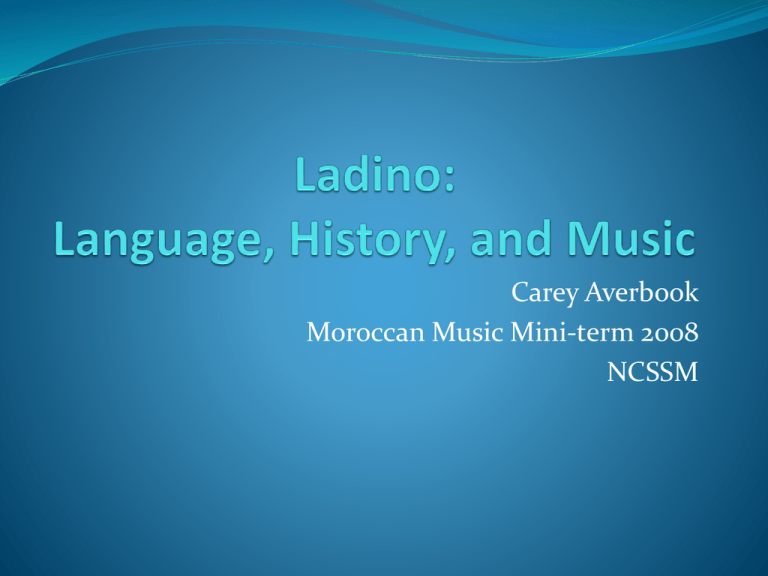
Carey Averbook
Moroccan Music Mini-term 2008
NCSSM
The Language
• Judeo-Spanish in essence
•Ottoman Empire
• Spoken primarily by
Sephardic Jews (Modern Day)
•“preserves many old words,
proverbs, songs, legends, and
romances.”
Microsoft ® Encarta ® 2007. © 1993-2006
Microsoft Corporation. All rights reserved.
Various Names of
‘Ladino’
•Called Ladino in Balkans
and Turkey, to distinguish
from Latin
•Known as Yahudice
(Jewish language) in the
Ottoman Empire
•Called Haquitiya in
Tangier and Tetuan (both
cities in Spanish Morocco)
•Northern Africa
This is a map of the Ottoman
Empire, early 1920s:
Comprised of N Africa,
Mediterranean, Balkans, and
Middle East
Who are Sephardic Jews:
The primary speakers of Ladino
Originally referred to Jews living and expelled from
Iberian Peninsula from 1492-1496
Expelled from Spain in 1492
Expelled from Portugal in 1496
Iberian Peninsula is present day Portugal and Spain
It now refers to the Jewish exiles and their descendants
who settled in the Ottoman Empire as well as
indigenous Jews who already lived in the countries.
Some of these Jews fled to the New World
History- Origins
• Origins in 1492, when
Jews were expelled from
Spain; they took their
language with them:
•
To the Ottoman
Empire
•Regional dialects
•It was the common
language of Salonika (a
city in Northern Greece)
during Ottoman rule.
•
Ladino remained
widely spoken
History- 20th Century
Carey averbook
•
Number of speakers declined due to the
Holocaust.
•
Ladino is in danger of extinction
•
Olim
•
However, there has been a minor revival
in Sephardic communities
•
Various countries in Latin America still
use the Ladino language
History- Modern
• Some Sephardic families
have lived in Jerusalem
for centuries, preserving
Ladino, even though
they use Hebrew in
everyday life.
The Language Today
About 200,000 speakers in the world, mostly in Israel
Number of speakers has diminished:
Pre WWI: 770,000 spoke Ladino in Greece alone
Other countries with native speakers include Turkey,
Bulgaria, Israel, Romania, Greece, Morocco, and Latin
American Countries
The borrowing of other languages is so heavy;
about 30% Ladino is of non-Spanish origin.
The Writing of Ladino
Written using the Hebrew alphabet
Retains much of 15th Century Spanish vocabulary and
Spanish spellings
Mediterranean influences
Ladino Literature
Focused on religious services and philosophy up to the
18th Century:
Literature in Ladino appeared in the 18th century
Three major categories:
Translations of sacred texts
Rabbinic literature
Folk tales, fables, proverbs, poems, and short stories
Examples of Ladino Literature
Translations of Hebrew Bible, High Holiday prayer book,
Passover Haggadah
Poetry of Shmuel HaNagid (993-1056), Shlomo ibn Gabirol
(1021-1058), and Yehuda Halevi (1075-1141), and treatises by
Yehuda Halevi, Moses Maimonides (1135-1204), and Hasdai
Crescas (1340-1410/1411)
Me'am Loez
Ejoha, otherwise known as Joha
Ladino Literature Today
• In 2001, the Jewish
Publication Society
• Matilda Koén-Sarano
• Writers are struggling
to keep Ladino literature
alive
• Ladino is not usually
published alone, but
with a Spanish or
Hebrew work
Ladino Music
• Songs are divided into
•Romansas/ ballads (dramatic
narrative poems)
•Kantigas (lyric songs,)
•Muwashshahat (poetical
forms)
•Survived for centuries
• In The Sephardic Experience,
there are many “references to
foods which were staples of the
Ottoman Sephardic diet”
• The Ladino music embodies
themes of “Sabbath food, tragic
births in the royal palace, joyous,
wicked, seductive, rejected and
spiritual love, and mischievous,
intoxicated, boisterous pre– and
post–nuptial hijinks.”
http://www.harmonies.com/releases/13169.htm
Comparison
• This audio clip is a Ladino version
of the Mourner’s Kaddish/ Yitgadal
ve-yitgadash
The Mourner’s Kaddish:
Hebrew Text
• Try to hear the Hebrew
Influences
English Translation:
Glorified and sanctified be God's great name throughout the world
which He has created according to His will. May He establish His
kingdom in your lifetime and during your days, and within the life of
the entire House of Israel, speedily and soon; and say, Amen.
May His great name be blessed forever and to all eternity.
Blessed and praised, glorified and exalted, extolled and honored,
adored and lauded be the name of the Holy One, blessed be He,
beyond all the blessings and hymns, praises and consolations that
are ever spoken in the world; and say, Amen.
May there be abundant peace from heaven, and life, for us
and for all Israel; and say, Amen.
He who creates peace in His celestial heights, may He create peace
for us and for all Israel; and say, Amen.
http://www.613.org/cantor/kadishs.ram MUST USE FIREFOX AND VLC PLAYER
Kantigas
Una Matica De Ruda:
Una matica de ruda
Una matica de flor
Hija mia mi querida
Dime a mi quen te la dio
Me la dio un mancevico
Que di mi s'enomoro
Hija mia mi querida
No t'eches a la perdicion
Mas vale un mal marido
Que un mancevo de amor
Mal marido, la mi madre
Un pilisco y la maldicion
Mancevo de amor, la mi madre
Una mansana y el buen limon
MUSIC!
A sprig of rue, a flowering sprig
My dear daughter, tell me, who gave
it to you
It was given me by a lad who fell in
love with me
My dear daughter, don't fall into
ruin
It's better to have a bad husband
than a young lover
A bad husband, mother, is a pinch
and a curse
A young lover, mother, is like a
(ripe) apple and a (fragrant) lemon
Romansas
Por Una Ninya (For One
Beautiful Girl)
Por una ninya tan ermoza
l'alma yo la vo a dar
un kuchiyo de dos kortes
en el korason entro.
No me mires ke'sto kantando
es yorar ke kero yo
los mis males son muy grandes
no los puedo somportar.
No te lo kontengas tu, ijika,
ke sos blanka komo'l simit,
ay morenas en el mundo
ke kemaron Selanik.
For a beautiful girl
I would give my soul
a double-edged knife
pierced my heart.
Don't look at me singing,
crying is what I want to do,
my sorrow is so great
I can't bear it.
Don't hold your sorrow, young
girl,
for you are white like bread,
there are brunette girls in the
world
who set fire to Salonika.
Muwashshahat
Includes a typical musical ABA form, intricate
melodies that are based on traditional rhythmic
modes, and performance by a chorus, with or without
soloists
Information and Music
Popular Song:
Cuando el Rey Nimrod
When King Nimrod walked through
the fields
Looking into the skies, reading into
the stars,
He saw the good star shining onto
the Jews
They where to give birth to
Abraham Avinu...
Abraham Avinu, beloved father,
Blesssed is thy name, light to
Israel...
Terachs wife knew she was pregnant
day to day he would ask her
- Why do you have such a full
blessed face
She was well aware the good she was
given.
http://www.savethemusic.com/ladi
no/bin/music.cgi?Page=reynimrod&
Singerbio=reynimrod_ncastel
“is a Ladino song that celebrates the
birth of Abraham. It incorporates
many elements taken from the
Nimrod midrashim. This song is
sung as a Shabbat z'mira (table
song) and at circumcisions. The
exact date of its origin is unknown
but it probably dates from the 16th
or 17th century.”
Romansa
http://www.savethemusic.com/ladino/bin/music.cgi?Page=reynimrod
&Song=about_reynimrod
Example of Sheet Music
Bibliography
Microsoft ® Encarta ® 2007. © 1993-2006 Microsoft
Corporation. All rights reserved.
http://www.sephardicstudies.org/images/grandeesladino2.jpg
http://www.goldenland.com/pictures/sons_sepharad.j
pg
http://spanish.about.com/cs/historyofspanish/f/ladin
o.htm
http://www.library.fau.edu/news/images/110707a.jpg
http://en.wikipedia.org/wiki/Ladino_language
Bibliography Cont.
http://www.worldstatesmen.org/Ottoman.jpg
http://www.jewishgen.org/Sephardic/sephardic_roffe.
HTM
http://www.ou.org/yerushalayim/kadish.htm
http://myjewishlearning.com/culture/literature/Europ
eanLit/LadinoLiterature.htm
http://www.ushmm.org/wlc/article.php?lang=en&Mo
duleId=10005422
http://www.harmonies.com/releases/13169.htm

